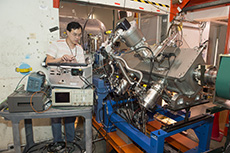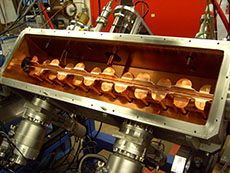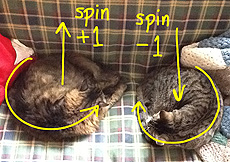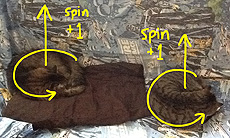|
Have a safe day!
Friday, Nov. 2
3:30 p.m.
DIRECTOR'S COFFEE BREAK - 2nd Flr X-Over
4 p.m.
Joint Experimental-Theoretical Physics Seminar - One West
Speaker: Venkatesh Kaushik, University of Arizona
Title: Recent Results from ATLAS
Saturday, Nov. 3
8 p.m.
Fermilab Arts Series - Auditorium
Natalie MacMaster
Tickets: $35/$18
Monday, Nov. 5
2:30 p.m.
Particle Astrophysics Seminar - One West
Speaker: John Peterson, Purdue University
Title: Simulating the Large Synoptic Survey Telescope (LSST) One Photon at a Time
3:30 p.m.
DIRECTOR'S COFFEE BREAK - 2nd Flr X-Over
4 p.m.
All Experimenters' Meeting - Curia II
Special Topics: Proton Improvement Plan; FTBF Wire Chamber Progress; LAPD Status; DECam Commissioning Status
Click here for NALCAL,
a weekly calendar with links to additional information.
Ongoing and upcoming conferences at Fermilab |
|
Friday, Nov. 2
- Breakfast: blueberry-stuffed French toast
- Hungarian pork goulash soup
- Chicken fajita sandwich
- Polish reuben casserole
- Smart cuisine: catch-of-the-day seafood linguine
- Eggplant parmesan panini
- Assorted pizza by the slice
- Breakfast-for-lunch omelet bar
Wilson Hall Cafe Menu
|
|
Friday, Nov. 2
Dinner
- French onion soup
- Grilled swordfish with white wine
- Butter sauce with capers
- Corn risotto
- Sautéed pea pods with red peppers
- Almond cake
Wednesday, Nov. 7
Lunch
- Chicken in a coconut curry
- Steamed jasmine rice
- Vanilla flan with mango sauce
Chez Leon Menu
Call x3524 to make your reservation.
|
|
Cockcroft-Walton's successor: a peep inside the new RFQ and how it works
 |
Fermilab scientist Cheng-Yang Tan stands to the left of the Fermilab's new radio frequency quadrupole. Photo: Reidar Hahn
|
In August, Fermilab said good-bye to its iconic Cockcroft-Walton generators. Now the new starting point for
Fermilab's chain of accelerators is in place. It's called a
radio-frequency quadrupole, or RFQ.
Last month, workers moved the laboratory's new, 3.5-meter-long RFQ to its
permanent home between one of the Cockcroft-Walton generators and the
front end of Fermilab's linear particle accelerator, or Linac.
Once in operation, the RFQ, together with its ion source, will act as the birthplace of particle beams for the laboratory's many experiments.
"The ion source and RFQ are the beginning of everything," said Cheng-Yang Tan, the lead physicist on the RFQ project. "They are the source of beam for the entire complex."
The RFQ will accept low-energy beam from an ion source at one end and inject accelerated and bunched beam out the other into the Linac.
It all starts with a piece of pure molybdenum the size of a tea bag, which serves as an electron supply.
To generate low-energy beam, scientists place the molybdenum cathode inside a small container in the ion source machine, which they then fill with hydrogen gas.
"This basically supplies all of the lab's particles," said the scientist in charge of the ion source, Dan Bollinger, as he held one of the laboratory's molybdenum pieces in his hand.
Like shy children who need encouragement to play with others, molybdenum's electrons need energy to excite them to leave the surface so the hydrogen atoms may collect them. The result is the catalyst for beam: a gas of H-minus atoms – negatively charged ions. With the generation of the ions, beam is born.
The real journey then begins: An "extractor" attracts the negative particles with a positive potential, sucking them through a hole about the width of a cello string while a magnetic field guides them in the right direction. The extractor feeds the beam into the RFQ proper. Once it gets there, it is a continuous stream of particles.
Read more
—Jessica Orwig
 |
A peep inside the RFQ: Four copper rods sit inside the RFQ. The line down the center reveals the wave structure that both bunches and accelerates beam. Photo: Pat Karns, AD
|
|
Power outages
This weekend's outages will limit your ability to work in many areas and require you to shut down your computer.
Accelerator Division computers and network services outage
On Friday evening, Nov. 2, Controls personnel will take down the AD computers and network services in preparation for the Saturday power outage. These systems won't be back online until noon on Monday, Nov. 5.
Feeder 40 power outage
On Saturday, Nov. 3, from 7 a.m. to 4:30 p.m. there will be a power outage to conduct feeder maintenance. This outage will affect the Linac, Cross Galleries, the Main Control Room and the Accelerator Division computer room.
Feeder 44 power outage
On Sunday, Nov. 4, from 7 a.m. to 4:30 p.m. there will be a power outage to conduct feeder maintenance. This outage will affect Wilson Hall and Ramsey Auditorium, which will be closed for all routine operations between 7 a.m. and 5 p.m. Emergency and exit lights will not be operational after the first 90 minutes of the power outage. For the duration of the power outage, only elevator cars 1 and 4 will be available. "Ask a Scientist" will be moved to CDF.
There will be no power or networking in Wilson Hall office areas and the WH5NW and WH8-Fiber Central computer rooms during the outage period. (FCC, LCC and GCC will be unaffected by this outage.) The LHC Remote Operations Center will have power, but won't have a network. See a list of known computing services affected.
Those whose offices are in Wilson Hall, please turn off your computers and small electrical devices in your office before you leave work today to avoid power disruptions on Monday morning.
Central Utility Building power outage
On Sunday, Nov. 4, from 7 a.m. to 5 p.m. there will be a cooling outage due to a CUB system outage. This lack of cooling will affect Wilson Hall, Linac Gallery, Cross Gallery, Booster Gallery and Towers, all the accelerators and the AD computer rooms. FESS personnel will provide temporary cooling for the MCR, Mac room, dispatch, telecom and a few other areas.
|
Unexpected 'ridge' seen in CMS collision data again
From Physics World, Oct. 31, 2012
The first data from proton-lead collisions at the Compact Muon Solenoid (CMS) experiment at the Large Hadron Collider (LHC) at CERN include a "ridge" structure in correlations between newly generated particles. According to theorists in the US, the ridge may represent a new form of matter known as a "colour glass condensate".
This is not the first time such correlations have been seen in collision remnants – in 2005, physicists working on the Relativistic Heavy-Ion Collider (RHIC) at Brookhaven National Laboratory in New York found that the particles generated in collisions of gold nuclei had a tendency to spread transversely from the beam at very small relative angles, close to zero. A similar correlation was seen in 2010 at CMS in proton-proton collisions and then later that year in lead-lead collisions.
Read more
|
|
Spin!
 |
| Spin is angular momentum, quantized into discrete units such as +1 and −1. |
Read the expanded column on spin.
In the original Karate Kid movie, the kid who wants to learn karate is frustrated by his teacher's insistence that he spend his time painting fences and waxing cars. Only later is it revealed that the student had learned the fundamental moves without realizing it, blocking punches with "wax on, wax off." Similarly, the deepest mysteries of physics are taught in Physics 101, but they're hard to recognize in everyday objects like bicycle wheels and spinning tops.
One of these deep principles is the conservation of angular momentum. Angular momentum is the amount of rotation an object has, taking into account its mass and size, and it is curiously constant. A spinning figure skater has a constant angular momentum as she contracts her arms and twirls faster because a fast-spinning small object has as much angular momentum as a slow-spinning large object. A cloud of interstellar dust, stately drifting in a slow inward spiral, can eventually collapse into a pulsar the size of a city block, feverishly revolving around its axis a thousand times per second. The angular momentum stays the same.
Fundamental particles are infinitesimal points of zero size, so it's hard to imagine what it even means for them to rotate. We can, however, measure their angular momentum, and it seems to always come in discrete multiples of 1/2 like −1/2, 0, +1/2, +1, and nothing in between. This is a quantum mechanical effect, and each particle has an intrinsic or built-in angular momentum called spin. Particles of matter, such as electrons and quarks, all have spin 1/2 (called fermions), whereas particles of force or energy have integer spins: 0, 1, and 2 (called bosons). Photons, which are particles of light, can have spin −1 or +1, a phenomenon that is known to photographers as circular polarization.
The new Higgs-like particle discovered this summer decays into two photons, and angular momentum must be conserved in that decay. If the new particle decays into opposite-spin photons, demonstrated by my cats in the top figure, then it must have had (+1) + (−1) = 0 spin, consistent with being a Higgs boson. If it decays into same-spin photons, then it must be a spin-2 particle, like a graviton. Scientists are currently striving to measure that spin because it makes a big difference in how we interpret this discovery.
—Jim Pivarski
 |
| Cats demonstrating same-spin photons, such as those from the decay of an excited graviton. |
|
In memoriam: Danny R. Douglas
Danny R. Douglas, 66, of Aurora, Ill., passed away on Oct. 31. He retired from Fermilab's Accelerator Division Mechanical Support Department after 40 years of service. Douglas was a proud veteran of the United States Army.
His family will receive guests at his memorial service on Saturday, Nov. 3, from 3 to 7 p.m. at Dieterle Memorial Home at 1120 Broadway in Montgomery, Ill.
Read Douglas' obituary.
|
Fermilab prairie seed harvest
Fermilab and the not-for-profit Fermilab Natural Areas will host their annual Fermilab Prairie Seed Harvest at 10 a.m. on Saturday, Nov. 3rd.
All ages and abilities are welcome to spend a day in the autumn prairie at Fermilab. This year the harvest will take place in the Robert F. Betz prairie located inside the main ring. Parking is available. Please watch for directional signs as you enter the Fermilab site. This event lasts until 2 p.m., and a hot-dog lunch will be provided. Come for the entire time or only a portion.
Fermilab staff and volunteers will show you what and where to collect. If you have them, please bring gloves, clippers and containers such as paper bags (especially with handles) or a 5-gallon bucket. Weather-appropriate, outdoor clothing is highly recommended, as are sturdy shoes.
This social event allows participants to enjoy the outdoors and learn about the ecological restoration program at Fermilab. Please call 630-840-3303 if you are bringing a large group. In case of bad weather, call the Fermilab switchboard at 630-840-3000.
|
|